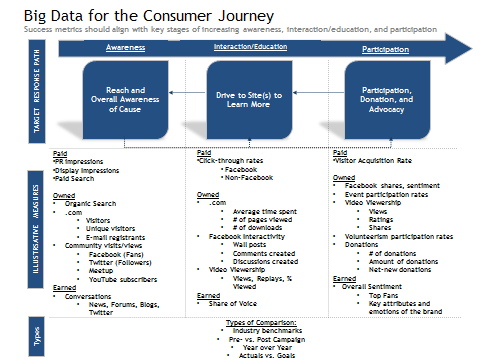 Think of the different ways certain tech phenomena have reshaped the world: intermodal containers in the 50’s, the digitization of music in the early 80’s, the web of the early 90’s. Today, big data is a type of summary event, an omnivore fed by the old and new, the physical and the digital. Jerry Nichols provides a framework for dealing with it in the social sector. The word here is “consumer” and the object, in this case, is the nonprofit. We could see parallel application for “stakeholder and foundation”, “beneficiary and ngo,” or a few other combinations. The point I appreciate is that a viable approach to any “big” phenomenon begins with understanding how people interact with your organization and business model. Jerry gives a practical case that takes us out of the abstract and into a start with big data. Let’s see how that might work.
Think of the different ways certain tech phenomena have reshaped the world: intermodal containers in the 50’s, the digitization of music in the early 80’s, the web of the early 90’s. Today, big data is a type of summary event, an omnivore fed by the old and new, the physical and the digital. Jerry Nichols provides a framework for dealing with it in the social sector. The word here is “consumer” and the object, in this case, is the nonprofit. We could see parallel application for “stakeholder and foundation”, “beneficiary and ngo,” or a few other combinations. The point I appreciate is that a viable approach to any “big” phenomenon begins with understanding how people interact with your organization and business model. Jerry gives a practical case that takes us out of the abstract and into a start with big data. Let’s see how that might work.
…
Big data is best characterized by four dimensions: (1) volume: the amount of information created, collected, and stored, (2) variety: the sources and types of information, (3) velocity: the speed that data are captured, processed, analyzed, and delivered through insights, and (4) value: the tangible contribution of business strategies and tactics, informed by big data, provide to the bottom line.
Organizations are awash with data — 90% of the world’s data has been created in the past 2 years alone and 2.5 quintillion bytes of data are created daily. This explosive growth is attributed to: (1) the proliferation of smart phones, social media, videos, scanner data, operational data marts, and (2) advances in technology that include both lower costs for data storage and increased/faster computing power of machines, which are becoming increasingly smaller. Much of the qualitative and emotion-based data from social media channels are public information, so organizations can leverage social media monitoring to understand, monitor, and influence the volume of conversations and tonality of their brand.
One way to drive value from big data is leveraging it to measure, monitor, and optimize the consumer journey of a marketing campaign. This process starts first with defining the primary goals of the campaign (e.g., increasing sales, decreasing time to market), and then mapping out the macro-level phases that occur throughout the consumer journey that lead to the desired outcome.
For non-profits, we may want to both increase participation in the cause (e.g., community size, volunteerism rates) and donations. In order to accomplish this (from a consumer journey perspective), we would first need to: (1) increase overall awareness of the brand, and (2) have more individuals interacting with the brand and learning more about it and its cause.
Once the consumer journey is defined, the channel strategy is aligned to each phase of the targeted response path including: paid media, owned media (properties owned by a brand [e.g., website, Facebook page, videos, and physical events]), and earned media (volume and sentiment of social media discussions.) The owned and earned media channels are mission-critical for non-profits, as they provide a lower cost option to reach consumers and have them interact with the cause.
Additionally, non-profit organizations can use social media as an “activation tool” by publishing time and/or event-specific content related to the cause (e.g., events such as a parade, walk, or even a national holiday), and by identifying and engaging with top influencers. It’s interesting to note that social media channels (e.g., Facebook, Twitter) are increasingly becoming an “owned” channel -– meaning that brands are now owning this space to proactively publish user content and participate in the consumer discussion through these valuable assets.
As illustrated below, once the consumer journey and channel strategy are defined, we can then leverage channel-specific metrics to baseline, measure, and monitor in-market performance.
The sources of big data for the consumer journey are varied, and metrics are driven by each source. Much of the paid media metrics would come directly from media company reporting, owned media metrics would come from both internal/corporate reporting and public tools (e.g., Google Analytics, Facebook Insights, and YouTube), and earned media metrics would come from robust social media monitoring tools. Once the reporting sources are identified, and metrics defined and evaluated (and agreed upon by stakeholders), an ongoing process to measure results throughout the campaign including: cadence, participants, and report format should be defined and agreed upon up-front.
To help set realistic Key Performance Indicators throughout the consumer journey, it’s best to benchmark historical performance where possible. The types of comparison for the benchmarking should include both industry benchmarks and year/year (to account for seasonality.) Once in-market, any opportunities or performance issues identified “upstream” in the consumer journey allows organizations more time and flexibility to impact results via in-market tactics.
In addition to optimizing the consumer journey, this process shows corporate responsibility via stated goals that are tracked and reported, including: (1) in-market for optimization and (2) post campaign for pre- vs. post- campaign and actuals vs. goals comparisons.
While the context within was for non-profit organizations, the approach for using big data for the consumer journey is similar in the for-profit arena. For-profit organizations (b2c and b2b alike) may place a greater focus on paid media performance (including: TV, out-of-home, radio, print, direct mail, and digital channels) and owned properties (including metrics from Customer Relationship Management systems, Enterprise Resource Planning systems, and HR talent management systems.)
Though it is mission critical for organizations to have complete, accurate, and timely information for decision-making, it’s the business objectives that should always drive the overall strategy and tactics of organization. Big data is an important means for the journey, but big data is not the journey itself.

